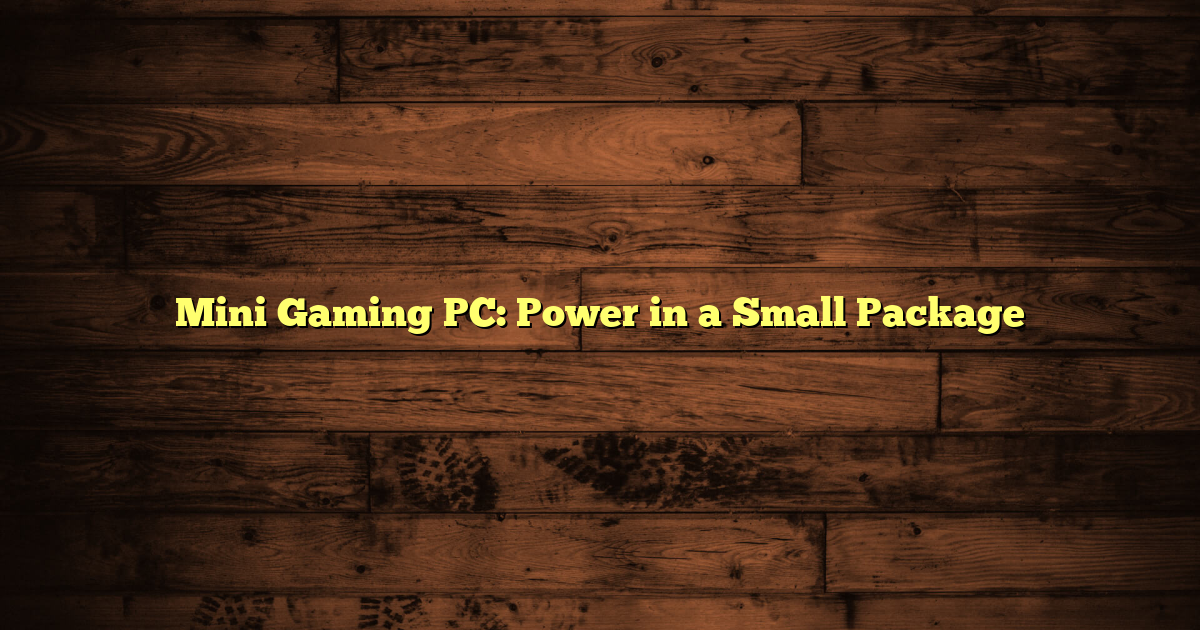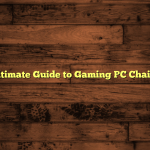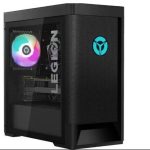Mini Gaming PC: Power in a Small Package
Table of Contents:
Performance Considerations
Memory and Storage
Connectivity & Expandability
Thermal Management Challenges
Use Cases & Limitations
FAQ
Mini Gaming PC: Power in a Small Package
Are you tired of bulky desktop towers cluttering your limited space? A gaming PC mini presents an intriguing solution: a small computer built to handle gaming. They strive to find a sweet spot between capability and portability, giving you the ability to enjoy recent games without the massive size of older desktop setups.
Performance Considerations
Usually, mini gaming PCs come with mid-range to top-tier CPUs with 4 to 8 cores. Clock speeds hover around 4.0 GHz or higher so you experience fluid gameplay. In order to prevent bottlenecks, processors like Intel’s Core i7/i9 or AMD Ryzen 7/9, are utilized. They can handle demanding games and multitasking.
While entry-level models typically include integrated graphics processors (iGPUs), many feature dedicated GPUs. These are often mobile versions, which increases graphical capability. However, they still maintain acceptable thermal levels in that small space.
Consider the ASUS ROG NUC 970 Mini Gaming PC. This one has an Intel Core Ultra 9 185H processor along with an NVIDIA GeForce RTX 4070 Mobile GPU. This pairing supports high-definition gaming at 1080p or even 1440p with great frame rates. This illustrates that mini PCs, despite their smaller size, provide solid performance. Performance is comparable to larger desktops for many popular game titles.
Memory and Storage
To play recent games smoothly, at least 16GB RAM is suggested. Some premium models may have as much as 32GB DDR5 RAM. This helps in multitasking. In addition, it prepares your system for future software necessities.
Storage setups typically employ NVMe SSDs. The smallest ones start around 512GB. This allows quick loading times for both the operating system and your game data. If you have a large game library, bigger capacities or additional external storage may be something you should consider.
Connectivity & Expandability
Even with their smaller size, well-designed mini gaming PCs supply many necessary ports. Think about accessories like mice, keyboards, external drives, monitors, as well as VR headsets. Frequently utilized outputs are HDMI (version 2.1), DisplayPort (up to version 2.1), USB Type-A ports (USB 3.x), also Thunderbolt ports. Thunderbolt ports allow fast data transfer and charging. All are essential for connecting multiple displays or high-speed devices.
However, physical limits are present in their compact design. This means upgrade options are more limited compared to full-sized towers. Some let you easily increase RAM, also storage, via accessible slots. GPU upgrades are typically not possible because discrete GPUs often get soldered onto the motherboard. Another option is to use integrated mobile versions.
Thermal Management Challenges
One difficult problem the mini gaming PCs face is effective thermal control inside the limited space. Top-end components create notable heat during gaming. Because of that, manufacturers utilize advanced cooling solutions, like heat pipes with fans that are optimized for low noise. These will still maintain sufficient airflow.
Thermal throttling may occur if cooling isn’t enough. This is where your CPU, GPU, or both slow down because they get too hot. Well-designed units lower this risk. They utilize careful component placement and smart ventilation.
Newest Mini Gaming PCs in 2025 (Sorted by Release & Specs)
1. ROG NUC (2025) – Ultimate Power in a Compact Beast
-
Model: RNUC15JNK9X28AAU
-
OS: Windows® 11 Home
-
GPU: NVIDIA® GeForce RTX™ 5080
-
CPU: Intel® Core™ Ultra 9 275HX
-
Storage: 2TB NVMe PCIe® 4.0 SSD
-
Form Factor: Mini PC
-
Ideal For: 4K/8K gaming, VR, and streaming
💡 Perfect for enthusiasts seeking high-end power in a console-sized body.
2. ROG NUC (NUC14SRK) – Versatile Mid-Range Option
-
Model: RNUC14SRKU9189A0I
-
GPU: RTX™ 4070
-
CPU: Intel® Core™ Ultra 9 185H
-
Storage: 1TB NVMe SSD
-
OS: Windows® 11 Home
💡 Balanced for gamers who want RTX power but at a reasonable size and price.
3. ROG NUC (NUC14SRK) – Budget-Ready Entry
-
Model: RNUC14SRKU7168A0I
-
GPU: RTX™ 4060
-
CPU: Intel® Core™ Ultra 7 155H
-
Storage: 512GB NVMe SSD
-
Use Case: Indie games, esports, media editing
4. GEEKOM IT15 (2025 Edition) – Premium Intel/Arc Combo
-
CPU: Intel Ultra 9 285H
-
GPU: Intel Arc 140T GPU (99 TOPS AI Performance)
-
RAM: 32GB DDR5
-
Storage: 2TB NVMe SSD
-
Display: 8K Quad Display Supported
-
WiFi 7, SD Slot, USB4
-
Price: $1,099.00
💡 Tailored for creators and AI-powered applications.
Performance Champions in 2025
| Model | CPU | GPU | RAM | Storage | Price |
|---|---|---|---|---|---|
| ROG NUC (2025) | Ultra 9 275HX | RTX 5080 | – | 2TB | 💰 Premium |
| GEEKOM IT15 | Ultra 9 285H | Arc 140T | 32GB | 2TB | $1,099 |
| GMKtec K11 | Ryzen 9 8945HS | Radeon 780M | 32GB | 1TB | $599 |
| BOSGAME M4 | Ryzen 7 7840HS | Radeon 780M | 32GB | 1TB | $439 |
Top Budget Mini Gaming PCs – Performance per Dollar
✅ GEEKOM AX8 Max
-
CPU: Ryzen 7 8745HS (up to 4.9GHz)
-
GPU: Radeon 780M
-
RAM: 32GB DDR5
-
Storage: 1TB SSD
-
Display: 4x 8K Support
-
Price: $749.00
✅ KAMRUI Mini PC
-
CPU: Ryzen 7 5825U
-
RAM: 16GB DDR4
-
Storage: 512GB SSD
-
Price: $279.93
-
Triple 4K Display, WiFi 6, BT 5.2
✅ BOSGAME P4 Light
-
CPU: Ryzen 7 5825U
-
RAM: 32GB
-
Storage: 1TB SSD
-
Price: $319.99
-
Supports: PS3 Emulator, Triple Display
-
Ports: HDMI, DP, Type-C
Honorable Mentions for Power Users
-
GMKtec EVO-X2 AI Mini PC
🔸 128GB LPDDR5X, 2TB SSD, Quad 8K Display
🔸 WiFi 7, USB4, Oculink
🔸 Price: $1,999.99
🔸 Aimed at extreme multitaskers and AI model runners. -
Reatan A9 Mini PC
🔸 Ryzen 9 7940HS, 64GB DDR5
🔸 2TB SSD, Radeon 780M, 8K Support
🔸 Price: $799.00
Key Trends in Mini Gaming PCs for 2025
🔹 Powerful GPUs in Small Form Factors
Thanks to advances in thermal and layout engineering, RTX 4080/5080 and Radeon 780M GPUs now fit inside compact boxes no bigger than a lunchbox.
🔹 Dual LAN + USB4 + WiFi 6E/7
Most models now offer dual 2.5Gbps LAN ports, multiple USB4/PD ports, and next-gen wireless for seamless gaming and streaming.
🔹 Silent Operation
Improved fan design and smart thermal throttling let even powerful models run whisper-quiet when idle or under light load.
🔹 AI Optimization
Some like GEEKOM IT15 and GMKtec EVO-X2 come optimized for AI workloads or include NPUs (Neural Processing Units).
Best Picks by Category
| Category | Best Model | Why |
|---|---|---|
| Best Overall | ROG NUC (2025) | Flagship power, RTX 5080, Ultra 9 CPU |
| Best Value | BOSGAME P4 Light | Ryzen 7, 32GB RAM, 1TB, $319 |
| Best for Creators | GEEKOM IT15 | Intel Arc GPU, 8K Display, 2TB SSD |
| Best Budget Option | KAMRUI Ryzen 7 Mini PC | $279, Triple Display, decent specs |
| AI/Dev Ready | GMKtec EVO-X2 | 128GB RAM, LPDDR5X, WiFi 7, AI-focused |
Final Thoughts
Mini gaming PCs are no longer underpowered novelties-they now compete head-to-head with full-size towers. Whether you’re a gamer, developer, or creative pro, there’s a powerful mini desktop ready to save you desk space without sacrificing speed. HashtagsUse Cases & Limitations
Mini gaming PCs are great when space is limited. Think dorm rooms or small apartments. They are helpful for LAN parties where portability is more valuable than pure power.
Other benefits include:
- Their quiet operation allows them to double as media centers.
- They can appeal to those seeking a secondary computer.
Limitations:
- They usually cannot equal full-sized desktop rigs when it comes to ultimate power, not even extensive upgrade paths.
- If you want very high frame rates at resolutions above QHD (1440p), a self-built large tower is a better choice.
- The cost per performance ratio is not as good because of the complex engineering. This is required to put powerful hardware into small cases.
Summary:
| Aspect | Mini Gaming PC Characteristics |
| CPU | Mid-to-high-end laptop-class CPUs; ~6–8 cores; ~4GHz+ |
| GPU | Integrated graphics on low end – discrete mobile GPUs |
| RAM | Minimum ~16GB DDR4/DDR5 |
| Storage | Fast NVMe SSDs starting at ~512GB |
| Ports | Multiple USB-A/USB-C/Thunderbolt + HDMI/DisplayPort |
| Cooling | Advanced compact cooling solutions |
| Upgradeability | Limited compared with full-size desktops |
| Ideal Use | Space-constrained setups needing decent game performance |
To summarize, mini gaming PCs are good in-between options. You get laptop portability as well as desktop power. They provide decent modern game support inside transportable packages. Most casual gamers value convenience as well as capability.
FAQ
These are some frequently asked questions to help you:
What is a mini gaming PC?
It’s a compact desktop computer that gives you gaming performance in a small size.
Are mini gaming PCs powerful enough for modern games?
Yes, many mini gaming PCs can run modern games at good frame rates, depending on the components inside.
Can I upgrade a mini gaming PC?
Some upgrades are possible, like RAM and storage, but GPU upgrades are typically not possible.
Are mini gaming PCs good for streaming?
Yes, models with capable CPUs and sufficient RAM can be utilized for streaming. However, keep thermal management in mind.
Resources & References:
- https://www.ign.com/articles/best-mini-gaming-pc
- https://www.pcgamer.com/hardware/gaming-pcs/best-mini-pcs-for-gaming/
- https://www.alktech.co/articles/review-asus-rog-nuc-970-mini-gaming-pc
- https://www.geekom.co.uk/are-mini-pcs-good-for-gaming
- https://www.pcgamesn.com/best-mini-gaming-pc
#MiniPC #GamingRig #ROG #Ryzen9 #RTX5080 #IntelUltra #8KGaming #Windows11 #WiFi7 #USB4 #DeskSetupGoals #CompactPC





